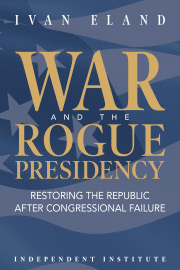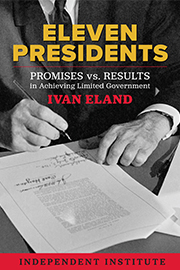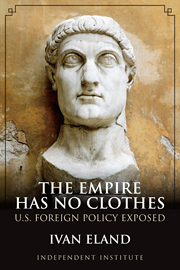Even a somewhat informed observer might wonder why President Donald Trump and the Republicans, who control all three branches of government and both houses of Congress, would need to rely on executive orders of questionable legality and constitutionality to finally accomplish the laudable goal of reducing the size of government as a percentage of GDP—which they have been rhetorically championing for decades but never seem to achieve.
For example, abolishing the Department of Education, which Republicans have long advocated, and at least trimming back the U.S. Agency for International Development need to be effectuated. However, in a republic, ends do not justify the means; following constitutional processes is paramount and should be easy given Republican control of all branches of government. Thus, that observer could and should conclude that the Trump administration is using questionable executive orders to realize these objectives, because its main goal, as was George W. Bush administration’s previously, is to dramatically expand executive power.
The most dramatic attempt to tip the balance of power among the branches of government is the Trump administration’s attempt to freeze government grants and contracts to make sure they complied with President Trump’s priorities.
Constitutionally, President Trump’s priorities flatly don’t matter. These are grants and contracts that have already been approved by Congress and signed by the previous president. If the president has allowed Elon Musk and his staff to penetrate the U.S. Treasury’s payment system to stop payments to programs, grants, and contracts that Trump disfavors, he is attempting, by another means, the equivalent of a line-item veto of certain spending.
The Supreme Court previously ruled such a veto unconstitutional; the president is allowed only to veto a congressionally passed bill in its entirety, the good with the bad, and President Joe Biden did not do so. Another possible ploy that the Trump administration has talked about using, similar to the prohibited line-item veto, has also been negated by the Budget Control and Anti-Impoundments Act of 1974, which nixed executive impoundment of funds when the president doesn’t feel like executing and enforcing congressional spending laws. The administration argues that this law is unconstitutional, but the Constitution clearly asserts that one of the president’s main responsibilities is to faithfully execute the laws—meaning whether he likes it or not. Moreover, one of Congress’ major powers is that of the purse—that is, to fund federal programs. If the president is allowed to usurp this power through a line-item veto, fund impoundment, a payment freeze, or selective payment, why have Congress in the first place?
And of course, instead of unconstitutionally freezing spending or deleting payment for items that have already been appropriated by Congress for this fiscal year, Trump could just wait to cut the next fiscal year’s budget, which is being formulated now and takes effect in October. However, many analysts believe the administration is deliberately using illegal or unconstitutional means to achieve its goals in order to generate court cases that will expand executive power past the imperial presidency that already exists.
The administration likely knows that it will lose some cases but might get to expand its powers in some areas because many of the Republican justices on the Supreme Court believe in the unitary of the executive. This theory of a powerful presidency on steroids believes that the president has unitary control over the executive branch and can do pretty much what he pleases with it, the Congress and the judiciary be damned.
One of the most extreme proponents of the theory is Vice President J. D. Vance, who has argued many times that the president should ignore court rulings that infringe on his rightful executive powers. He recently declared that “judges aren’t allowed to control the executive’s legitimate power.” Yet, if the administration ignores judicial rulings, it will trigger a constitutional crisis of immense proportions.
Since 1803, the Supreme Court has adjudicated whether congressional legislation and executive behavior comport with the Constitution. The court has not always been right, but it generally has been obeyed. The Trump administration is trying to steamroll both the judiciary and Congress using the unitary executive theory. Yet the delegates to the Constitutional Convention, with King George III in mind, were leery of unlimited executive power and thus gave the most enumerated powers to Congress, assigning the legislative body powers that the king traditionally possessed (declaration of war) or making the executive share them with Congress (treaty-making power and power to appoint executive officials).
In addition, from the George Washington administration until the 1920s, each executive department or agency, which the Congress created, negotiated its budget directly with the appropriate congressional committees—with the White House having little involvement. In fact, the congressional power of the purse was so revered that law governing the U.S. Treasury required the department to report to Congress and the president. Thus, President Washington generally refrained from intrusive management of Treasury’s affairs.
In conclusion, the Founders intended that the executive and the judiciary were to serve as checks on a dominant Congress. The president was to merely execute the laws passed by Congress, and many thought that the judiciary was to keep the two other branches within constitutional bounds. The unitary executive theory is an ahistorical latter-day invention, often resembling the theory of the “living Constitution” espoused by the left.
Thus, the Trump administration is currently pushing U.S. constitutional checks and balances to the breaking point by trying to further usurp Congress and threaten the judiciary.


